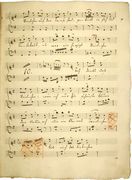Erwin und Elmire in the Collection of the Deutsches Nationaltheater, Weimar: For the 275th Birthday of Anna Amalia, Duchess of Sachsen-Weimar-Eisenach
Friday, October 24, 2014

The following article was written by our RISM Germany colleague, Undine Wagner, of the Thüringisches Landesmusikarchiv.
The Court of the Muses in Weimar and Anna Amalia’s roundtable salon, to which luminaries such as Goethe, Wieland and Herder belonged, have become catchphrases in the cultural history of Weimar. Anna Amalia (born Princess of Braunschweig-Wolfenbüttel on 24 October 1739 in Wolfenbüttel, died 10 April 1807 in Weimar) entered the Weimar court through her marriage to Duke Ernst August II Constantin von Sachsen-Weimar-Eisenach (lived 1737–1758) in 1756. From 1759 to 1775, she functioned as the sole regent for her infant son Carl August (1757–1828). After he took over the affairs of state in 1775, the dowager duchess could dedicate herself to her multifaceted artistic and intellectual pursuits. Anna Amalia had received a solid musical education as a singer and instrumentalist (harpsichord, piano, harp, flute) and also composed. For the Weimar Liebhabertheater, an amateur theater which Goethe led starting in 1775, she set the first version of his Singspiel text Erwin und Elmire to music. The work, which was premiered on 24 May 1776 and was performed six more times until 1778, can still be heard today from time to time (such as at the Liebhabertheater in Schloss Kochberg, south of Weimar). The original score and a few handwritten parts were lost in the fire that struck the Duchess Anna Amalia Library (D-WRz) in 2004.
The comprehensive historical music collection of the German National Theater in Weimar (Deutsches Nationaltheater Weimar), which is today held on deposit at the Hochschularchiv/Thüringisches Landesmusikarchiv in Weimar (D-WRha), also includes material for Anna Amalia’s Erwin und Elmire (D-WRha DNT 6b). The vocal parts for Elmire, Erwin, Olympia, and Bernardo, together with scripts for the spoken dialogue, are preserved in manuscript copies dating from around 1800. Of the musical numbers, which are at times songlike and at other times more arioso, special mention may be made of duet no. 6 (Elmire/Bernardo): “Ein Veilchen auf der Wiese stand” (“A violet stood in the meadow;” see picture), whose text was set to music with the title “Das Veilchen” by numerous composers – independent of Anna Amalia and Goethe’s Singspiel.
There are also three printed copies of the piano score from the early twentieth century with the half title:
Erwin und Elmire | ein Schauspiel mit Gesang | von | GOETHE | komponiert | von | Anna Amalia | Herzogin | zu | Sachsen-Weimar-Eisenach | 1776
and the full title:
ERWIN UND ELMIRE | EIN SCHAUSPIEL MIT GESANG | VON | GOETHE | KOMPONIERT | VON | ANNA AMALIA | HERZOGIN ZU SACHSEN-WEIMAR-EISENACH | 1776 | NACH DER | IN DER WEIMARER | LANDESBIBLIOTHEK | BEFINDLICHEN HANDSCHRIFTLICHEN PARTITUR | BEARBEITET | UND ZUM | ERSTENMAL HERAUSGEGEBEN | VON | MAX FRIEDLAENDER | LEIPZIG 1921 | C.F.W. SIEGEL’S MUSIKALIENHANDLUNG | (R. LINNNEMANN)
One of the copies of the piano score was used as a production book and another as a prompt book. In the latter case, the following is written in pencil at the top of the first flyleaf: “19. Mai 1928. W. Schlimme. Opernsouffleur | Bad Pyrmont. Deutsches Nationaltheater | Weimar | 1. Juni 1928. Weimar | Deutsches Nationaltheater.” Handwritten parts of the four singing roles (also with scripts) and two instrumental parts (vla, vlc et b) that go with the piano score are still extant from this same time. These as well as the older parts show strong evidence of use: names of singers, insertions, marks, and other notes are written in.
Image: No. 6, Duet, Elmire/Bernardo: “Ein Veilchen auf der Wiese stand” (measures 4–28), from Erwin und Elmire by Anna Amalia von Sachsen-Weimar-Eisenach, D-WRha DNT 6b, Elmire’s part, f.7r
Share Tweet EmailCategory: Musical anniversaries

